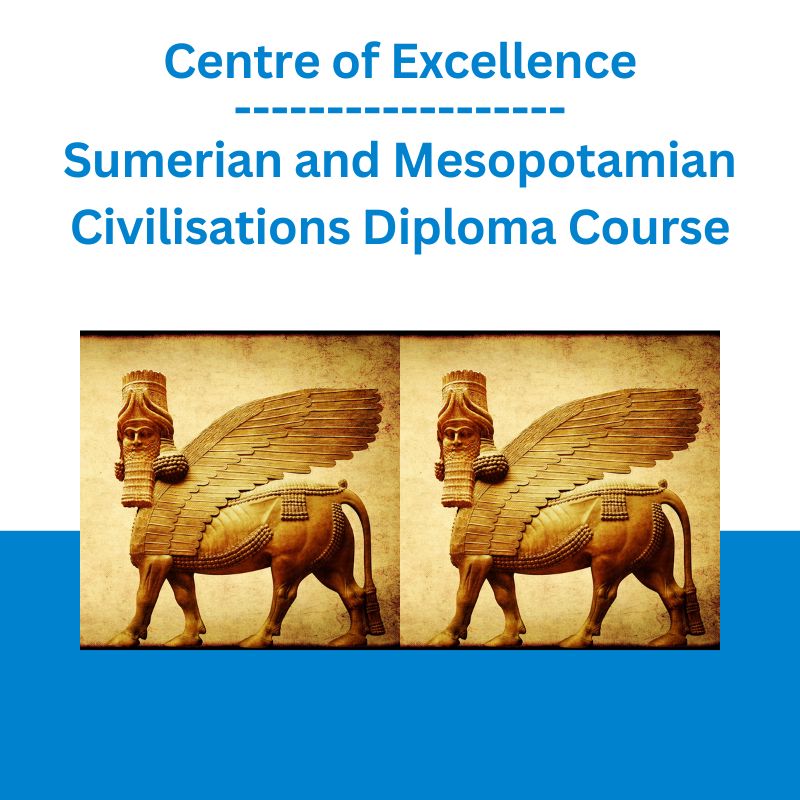*** Proof of Product ***
Exploring the Essential Features of “Centre of Excellence – Sumerian and Mesopotamian Civilisations Diploma Course”
What Will You Learn?
As long as 4,000 years ago, there was a region that was so advanced that some of the innovations that developed from there, such as the wheel and the zodiac, are still in use today. That place is Mesopotamia, an ancient land that covered modern-day Iraq, and the first civilisation it bore – which is also the first civilisation in the world – was called Sumer.
In the Sumerian and Mesopotamian Civilisations Diploma Course, you will learn exactly how advanced these ancient people were. You will study their mastery of irrigation and agriculture, how they developed complex urban societies, and their incredible ways of thinking about the world through writing, art, literature, astrology and even warfare.
The Sumerian and Mesopotamian Civilisations Diploma Course begins by laying the foundations of the subject with a geographical study of where Mesopotamia was and providing a chronological breakdown of the different people and empires that resided in ancient Mesopotamia.
From this overview, we dive straight into an exploration of some of the better-known Sumerian inventions, including the basic concepts of time and a city, the use of clay and the development of bricks, the wheel, the chariot, hydraulic engineering, and the sailboat.
You’ll be introduced to the development of the concept of a city and the city-state in Sumerian culture. You’ll study the different types of buildings that featured in a Sumerian city and the main features of this civilisation’s architecture.
We examine the role of religion in Sumerian civilisation, Sumerian cosmology, their Creation Myth and the primary deities they worshipped. We also look into the formation of cuneiform – the world’s first writing system – and discuss the rich literary tradition that cuneiform instigated.
You’ll learn of the importance of rivers in Sumerian and Mesopotamian culture, the rise of the city-states, the constant fighting for land and water, and how all three coalesced to cause the downfall of the world’s first civilisation.
We observe the rise and fall of the Akkadian Empire – learning about the first emperor, Sargon the Great, as well as the rich contributions the Akkadians made to the world. We look at the periods in which the Assyrians rose to power, the various kings who were most significant during these eras, and the contributions – good and bad – that they made to their own world and the world that continued long after their empire disappeared.
You’ll be introduced to two of the most important kings in Babylon and Mesopotamian history – King Hammurabi and Nebuchadnezzar II – who ruled during the Neo-Babylonian era. You will also study the contributions that this remarkable city made to humankind, from the first written laws to astronomy and the zodiac.
The course concludes with a look into the final few centuries of the Mesopotamian civilisation. This includes learning about the various foreign powers that overtook the region, including the Persians under Cyrus II and the Greeks under Alexander the Great.
By the end of this course, you will:
- Know why Mesopotamia is so important to civilisation
- Understand why Sumer was considered the ‘Cradle of Civilisation’
- Be familiar with the different empires that formed Mesopotamian history
- Appreciate the many innovations and inventions developed by the Sumerians that are still in use today
- Be aware of the different features of art and architecture throughout the history of Mesopotamia
- Understand the role of religion and the primary deities of Sumer and other Mesopotamian cultures
- Be familiar with the world’s first writing system, cuneiform
- Be aware of the major works of Mesopotamian literature
- Comprehend the contribution the Akkadians, Assyrians and Babylonians made to the world
- Know who the rulers of Mesopotamia were
- Have knowledge of some of the most important Mesopotamian artworks and cultural artefacts
- Understand what happened to the Mesopotamian civilisation
Course Syllabus
What will I learn on the course?
Module 1: The Origins of Mesopotamia and the Influence of Sumer
8 parts
Introduction
Part 1: Where is Mesopotamia?
Part 2: Stone Age to the First Civil Age in Mesopotamia
Part 3: The Rise and Fall of Sumer and the Akkadian Period
Part 4: By the Rivers of Babylon
Test Your Knowledge
Key Learning Points Exercise
Module 1 Assessment
Module 2: Sumerian Innovations and Inventions
7 parts
Part 1: The ‘39 Firsts’
Part 2: Time, Numbers, Astrology and Writing
Part 3: The Concept of the City
Part 4: Mass Production, the Wheel and Chariot, Hydraulic Engineering and the First Sailboat
Test Your Knowledge
Key Learning Points Exercise
Module 2 Assessment
Module 3: Cities and Architecture
6 parts
Part 1: Urban Planning
Part 2: Houses and Temples in Ancient Sumerian Cities
Part 3: City-States
Test Your Knowledge
Key Learning Points Exercise
Module 3 Assessment
Module 4: The Religion of Ancient Sumerians
7 parts
Part 1: The Power of Priests
Part 2: Cosmology and the Sumerian Creation Myth
Part 3: Humankind’s Place in the World
Part 4: Primary Deities
Test Your Knowledge
Key Learning Points Exercise
Module 4 Assessment
Module 5: Writing and Literature
6 parts
Part 1: Sumerian Cuneiform and Token System
Part 2: The Beginning of Literature
Part 3: Similarities Between Sumerian Literature and Biblical Stories
Test Your Knowledge
Key Learning Points Exercise
Module 5 Assessment
Module 6: The Rise and Fall of the Sumerian Civilisation
6 parts
Part 1: The Importance of the River and How City-States Came to Be
Part 2: The Sumerian King List
Part 3: The Beginning of the End of the Sumerians
Test Your Knowledge
Key Learning Points Exercise
Module 6 Assessment
Module 7: The Akkadian Empire
8 parts
Part 1: Introduction to the Akkadian Empire
Part 2: King Sargon the Akkadian, First Emperor of Mesopotamia
Part 3: Achievements of the First Empire
Part 4: The Akkadian Empire Under Naram-Sin
Part 5: The Third Dynasty of Ur and the Birth of Abraham
Test Your Knowledge
Key Learning Points Exercise
Module 7 Assessment
Module 8: The Assyrians
6 parts
Part 1: Introduction to the Assyrians
Part 2: The Old Kingdom and the Middle Kingdom
Part 3: The Neo-Assyrian Empire and the Fall of the Assyrian Empire
Test Your Knowledge
Key Learning Points Exercise
Module 8 Assessment
Module 9: Babylon – The Centre of Mesopotamian Civilisation
9 parts
Part 1: The Origins of Babylon
Part 2: Hammurabi and the Rise of Babylon
Part 3: The End of the Rule of Hammurabi and the Dark Ages
Part 4: Rebuilding Babylon
Part 5: Maths, Science and Astrology
Part 6: How Babylon Became (In)Famous
Test Your Knowledge
Key Learning Points Exercise
Module 9 Assessment
Module 10: Cyrus the Great and the Demise of Mesopotamia
7 parts
Part 1: The Persian Invasion of Babylon
Part 2: The Demise of Mesopotamia
Part 3: Classical Antiquity (500 BCE – 7th Century AD) and the Legacy of the Mesopotamians
Test Your Knowledge
Key Learning Points Exercise
Conclusion
Module 10 Assessment
Who Would Benefit from This Course?
If you love history and discovering other cultures, but don’t know about the Sumerian and Mesopotamian civilisations, you’re really missing out. This course will fill in the blanks of your historical understanding and open you up to a whole new world that is the foundation of our own.
For so long, Mesopotamia has been in the shadow of other fascinating cultures such as ancient Egypt, Greece, and Rome but their histories are actually closely tied. This course will take you on a journey through the Sumerian and Mesopotamian civilisations and all the inventions and innovations that they are responsible for that we still use today.
Please see the full list of alternative group-buy courses available here: https://lunacourse.com/shop/









